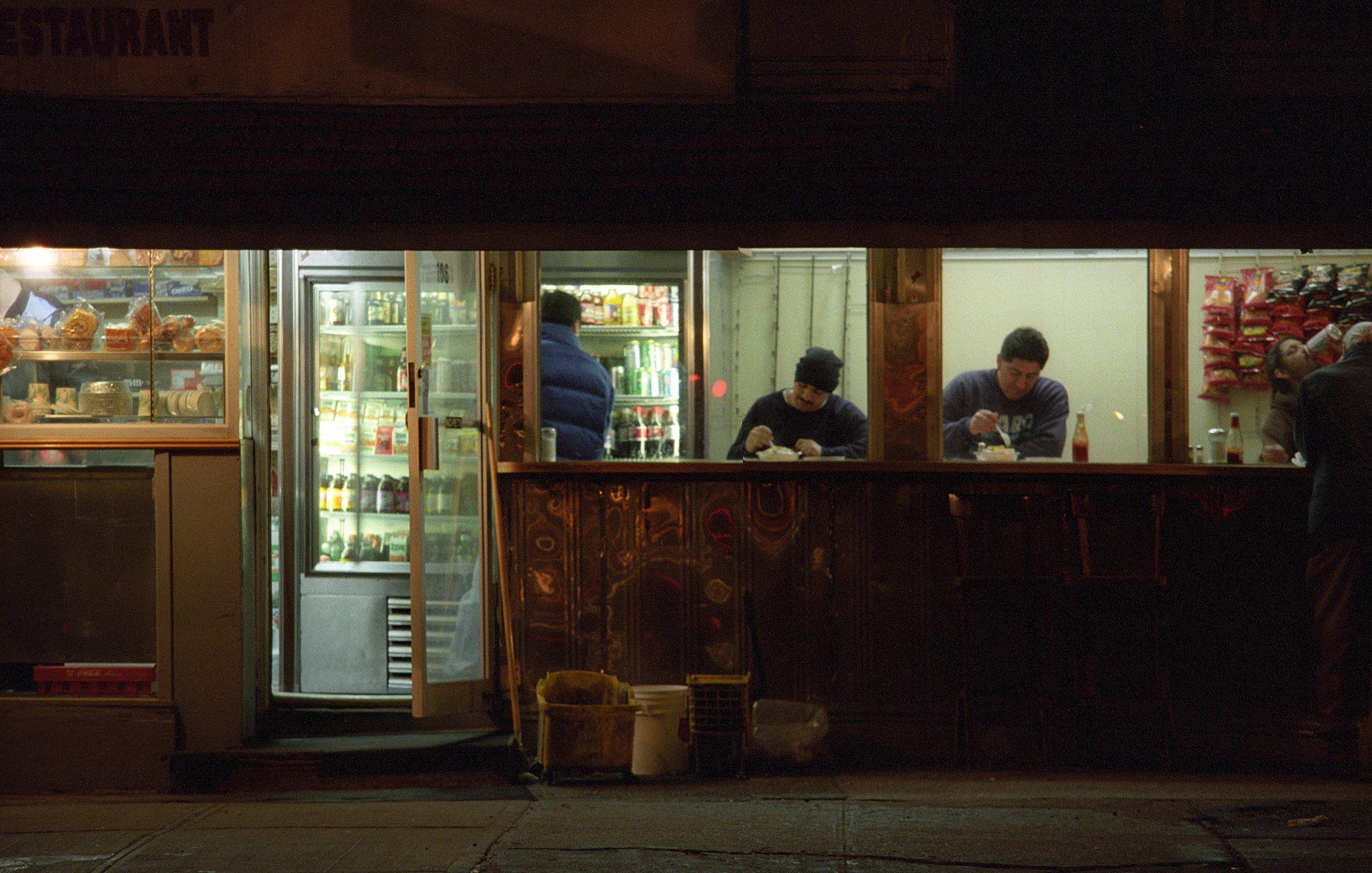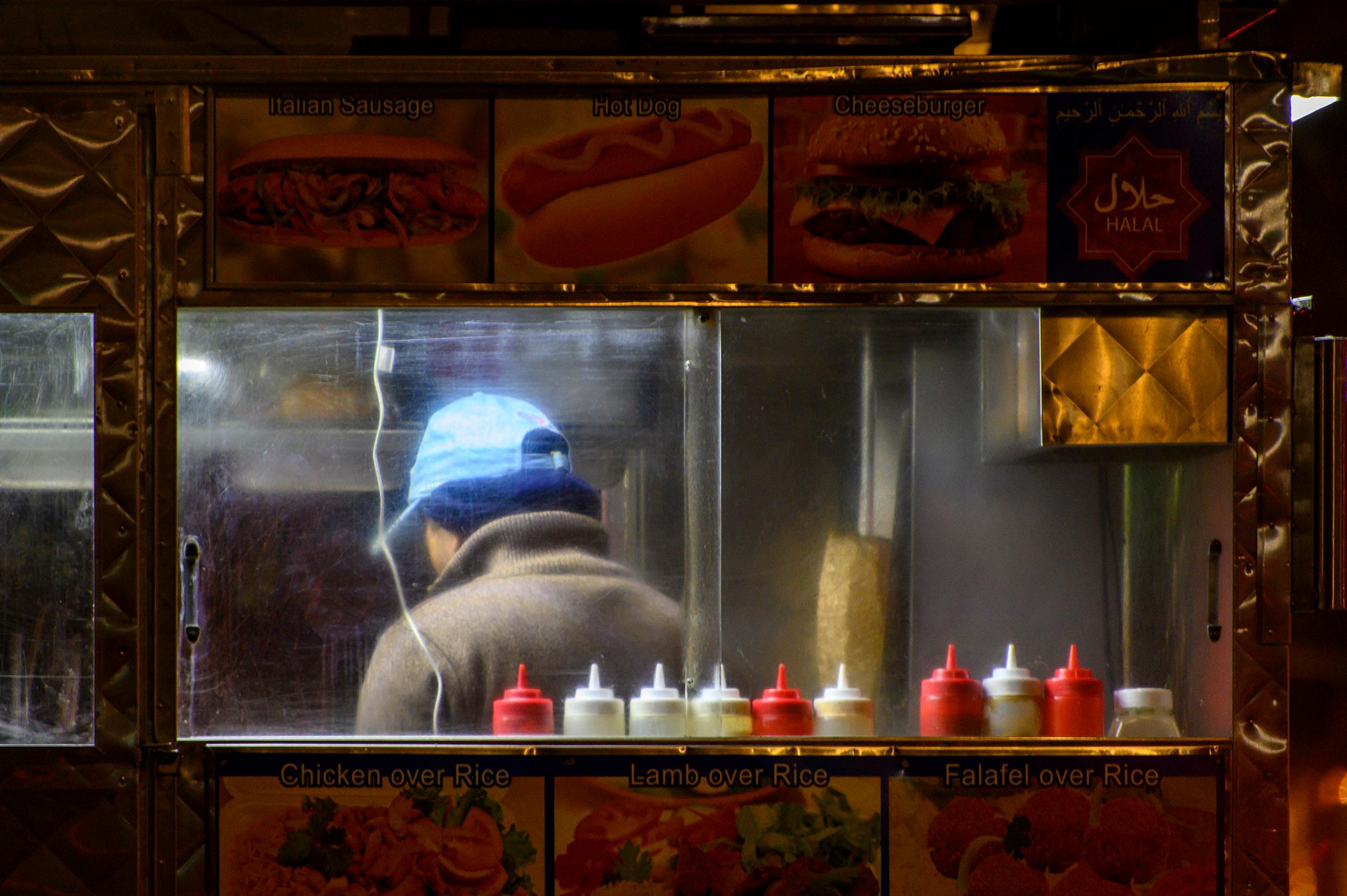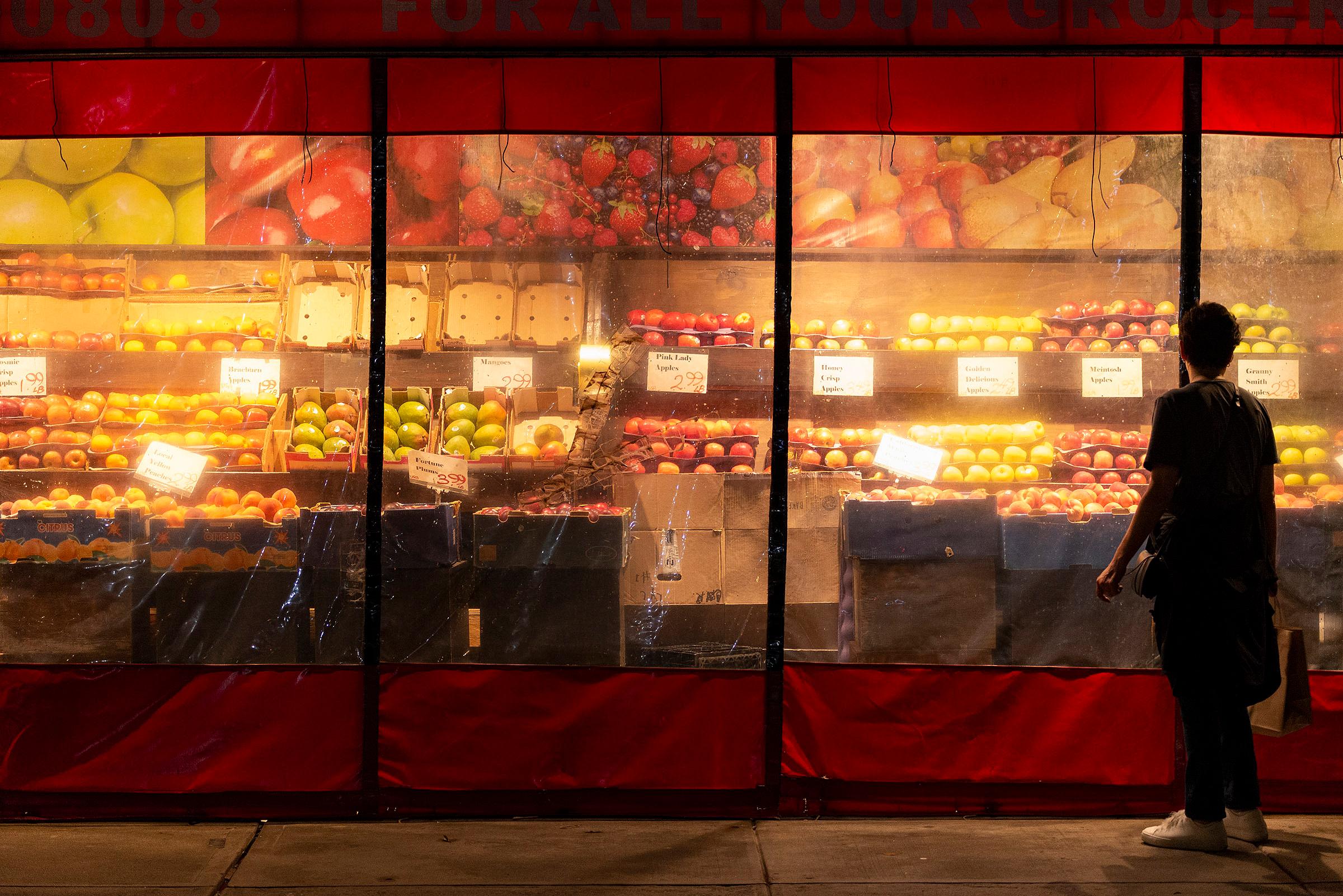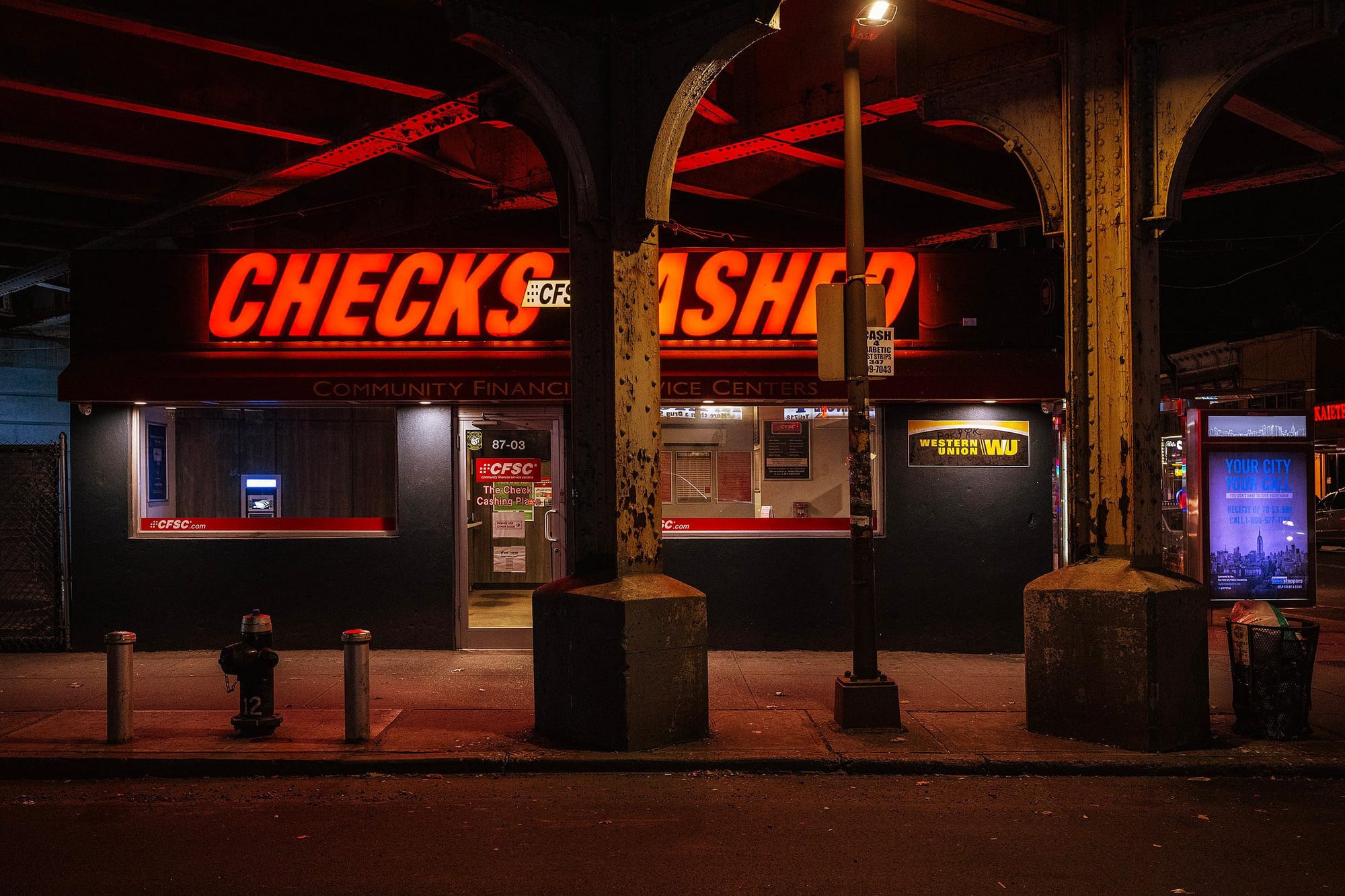PRIVATE/NYC: Photos by Paul Vlachos, New York City, 1998 ‑2023
Art Cake
214 40th St.
Brooklyn, NY
Through Dec. 23, 2023
Paul Vlachos’ haunting photos of vacant spaces of a check-cashing store, a fortune teller’s parlor, a dry cleaner, a lingerie shop, convenience stores, other empty storefronts, and alleys feel like exoskeletons, where the loneliness of souls and spirits linger in the thick air.
People who needed money fast, had hopes and dreams, things to do, and places to go are gone. When I visited the show of Vlachos’ work on display through this week, these images reminded me of the eerie foretelling of the neutron bomb that decimated humans but left the bones of our civilization to tell our stories.
Vlachos stated that the essence of his “PRIVATE/NYC” show lies in the first line of E.B. White’s book, Here Is New York. It reads: “On any person who desires such queer prizes, New York will bestow the gift of loneliness and the gift of privacy.”
A gallery visitor told the artist, “Thank you for helping me fall in love with New York all over again.”
I viewed the more than 50 color photographs in his exhibition at Art Cake in Brooklyn to understand this compelling allure of images of privacy and solitude in New York City.
Reminiscent of Edward Hopper’s paintings, Vlachos’ rich hues, lighting, and framing, evoke a similar sense of melancholy and isolation, even when sitting or standing right next to other people. Living in the most populous city in the United States, all New Yorkers have experienced feeling alone amongst strangers in a crowd, in a restaurant, or even at home in an apartment building.

In KENMARE AND CENTRE STREETS — 1998, a view through a corner deli’s windows catches two men looking down, silently eating their food at a countertop. A third man close by but with his back against the diners, checks out the food in refrigerators. At the edge of the picture, two people drink and eat, seemingly oblivious to the others. Although amidst other people, the men are not interacting but appear alone. The dark hues, composition, and sense of loneliness resemble Hopper’s famous oil painting, Nighthawks (1942), which depicts four people in a diner, lit on the inside like Vlachos’ deli. On its website, the Art Institute of Chicago, which owns the Hopper painting, describes “geometric forms and the glow of the diner’s electric lighting.”
The website quotes Hopper recalling, “‘unconsciously, probably, I was painting the loneliness of a large city.’” It notes the painter was inspired by a restaurant in Manhattan.
Vlachos said that he loves Hopper and that he has been told his photos are “Hopperesque.” But the similarities in their work seem unintended. Vlachos explained that he has long gravitated toward inanimate objects and scenes that resonate with him. “I like these weird, lonely, anonymous spaces,” he said.

The show displays a slice of New York, spanning 25 years from 1998 to 2023. Moving from the deli, 20 years later, to another eating establishment, the MANHATTAN — 2018 shows the backside of a man’s head topped with a baseball cap, and his shoulders. With its uncanny Hopperesque imagery of urban loneliness, bottles of ketchup, mayonnaise, and mustard are the central characters in the foreground.
The bright colors, geometric shapes, and illuminated interiors, like a brief, stolen kiss, encapsulate a moment of privacy in a hard-working, driven city that never sleeps.
The man’s thoughts are his own. In a crowded metropolis of more than 8 million people, this image and others in the exhibition reminded me of US Supreme Court Justice Louis Brandeis’s dissent in Olmstead v. United States (1927), articulating privacy as “the right most valued by all civilized men — the right to be let alone.“
That case focused on governmental intrusion in wiretapping, without judicial approval, a suspected bootlegger’s telephone during Prohibition. Although Justice Brandeis was defining a constitutional right, his words highlight the hidden comfort of anonymity that New York can uniquely provide.

Vlachos shoots images without filters but in the raw format, and adjusts contrast, color, and brightness. He sends the digital files to be printed, using ChromaLuxe technology that with high heat infuses the images onto aluminum. The rectangular pictures are mounted on the back on frames protruding about an inch from the wall, appearing almost like small video screens.
“These are shinier, and have a couple more microns of depth, adding to the 3‑D effect,” said Vlachos. “The colors are richer.”
The artwork is priced from $400 to $800 depending on size, with limited printing of no more than three prints per size.
DOWNTOWN NYC — 2022 is a luminous image of a lone woman looking into a store at its stacked, fresh produce. Inanimate objects, still life of fruit, dominate the scene. Glowing apples appear like lighted, votive prayer candles, beneath a painted mural in a house of worship. Details of cellophane streak down in ghost-like shapes visiting the Earth.
“In a huge, anonymous city, everyone is essentially alone most of the time,” said Vlachos.
The solitude of privacy can be a double-edged sword with loneliness as the reverse blade. The frenetic, hustle-bustle of New York exaggerates this inescapable human condition. This is perhaps at the core of our lives — truths that resurface in the law, literature and art.
The images reminded me of the play, The Pavilion by Craig Wright. A boy impregnates his high school girlfriend, then leaves town. She terminates her pregnancy. Years later he returns home to a class reunion with hopes of building a life with her. The narrator reminds him that time goes only in one direction, saying: “Say ‘no’ to time; hold on to what you were or what she was; hold onto the past, even out of love … and I swear it will tear you to shreds. The universe will tear you to shreds.”
Vlachos’ photos can freeze images of time. But there is heartbreak in recognizing our impotent inability to stop time.
Perhaps New Yorkers love New York for its unspoken acknowledgement of being together in loneliness. Being together but being alone. Death is inevitably a private experience. Ironically, it’s the one experience we all universally have alone. But there is beauty in knowing that we were here.






